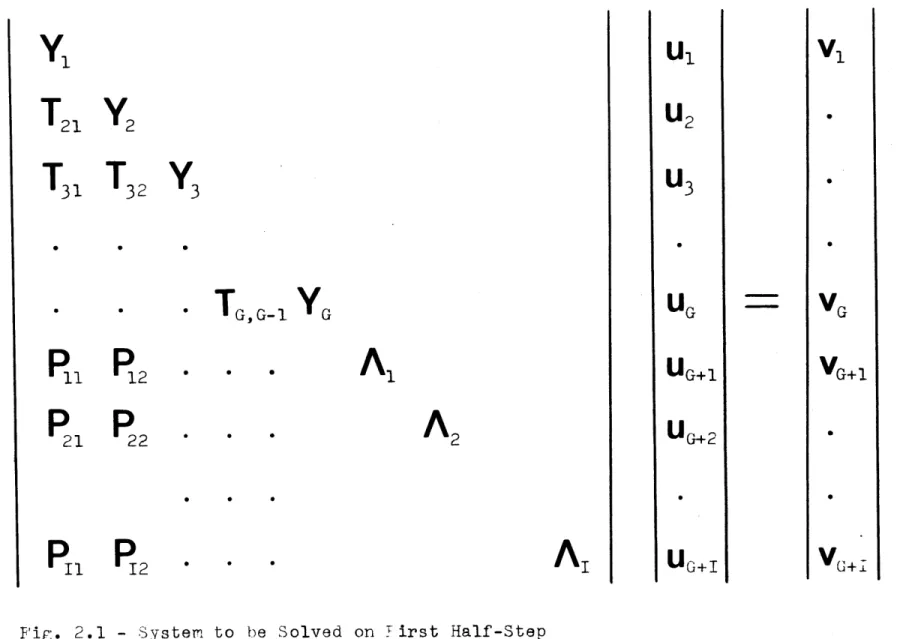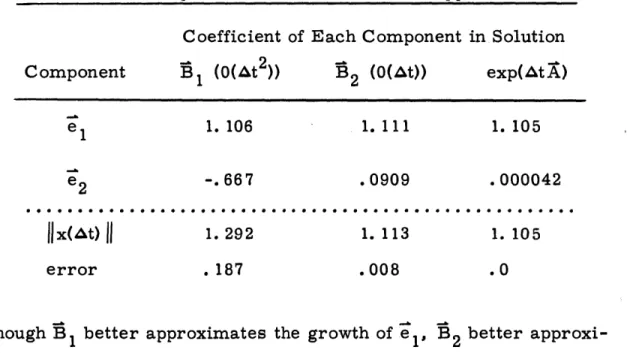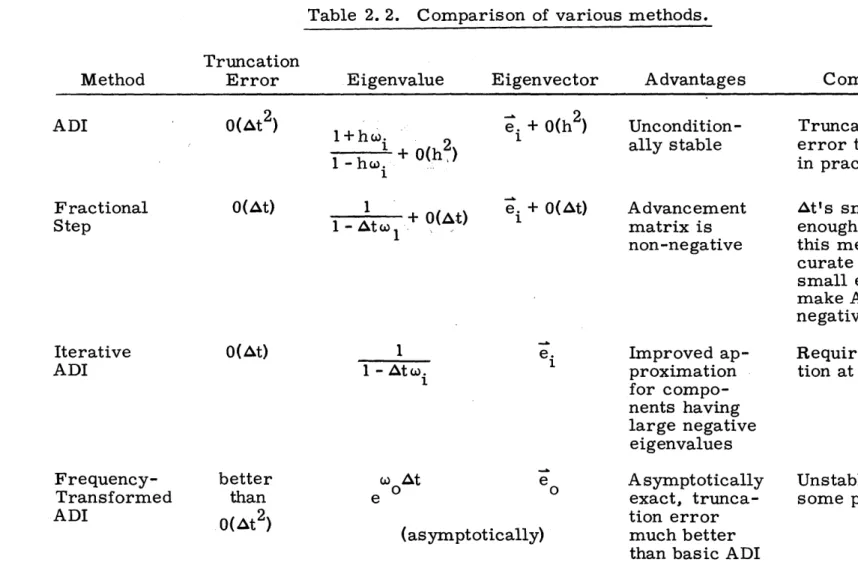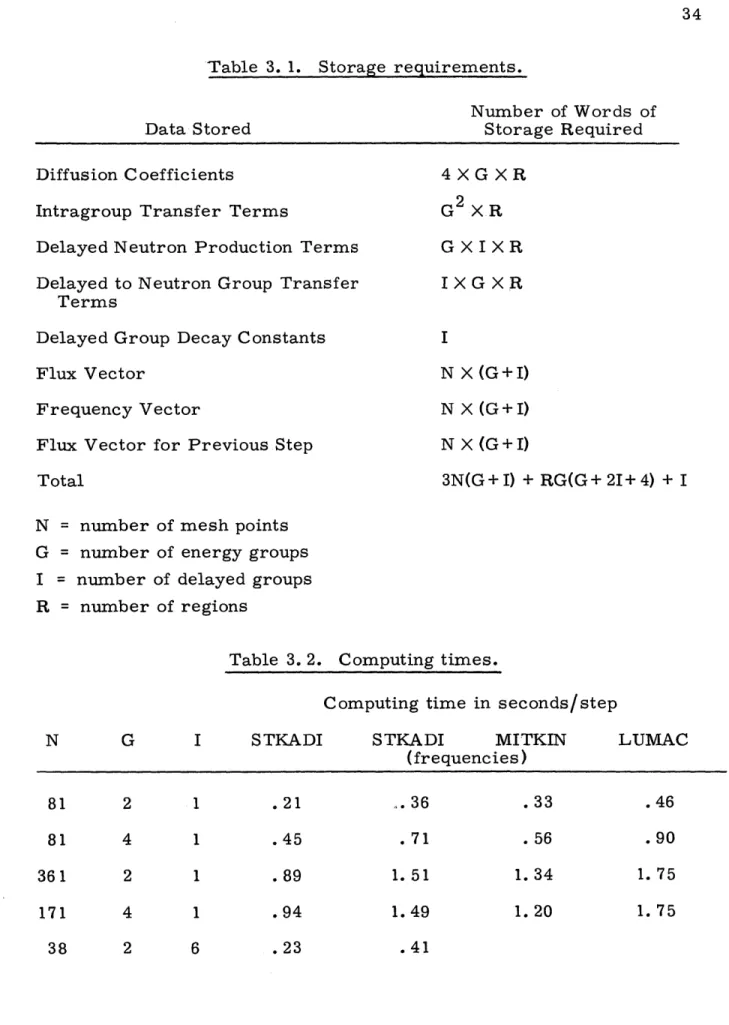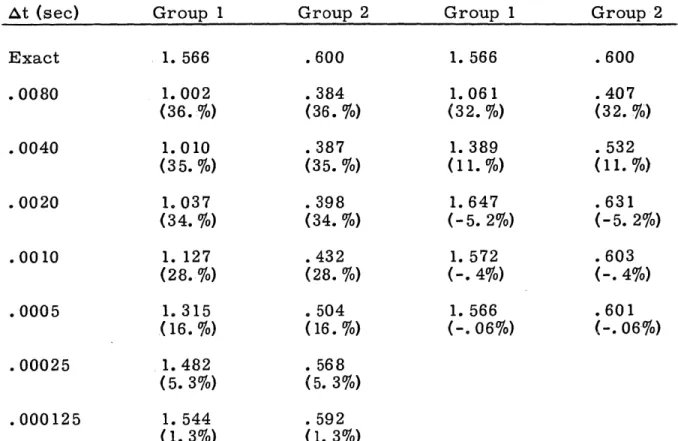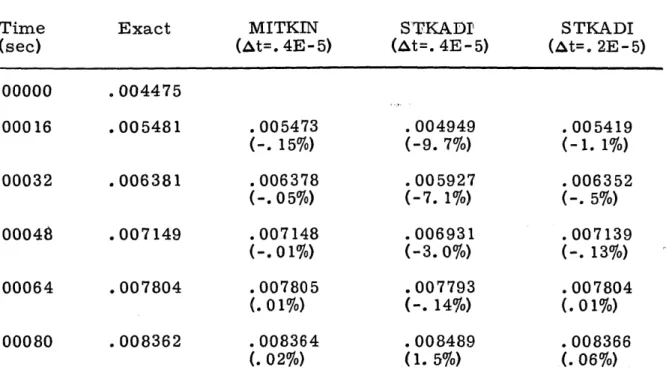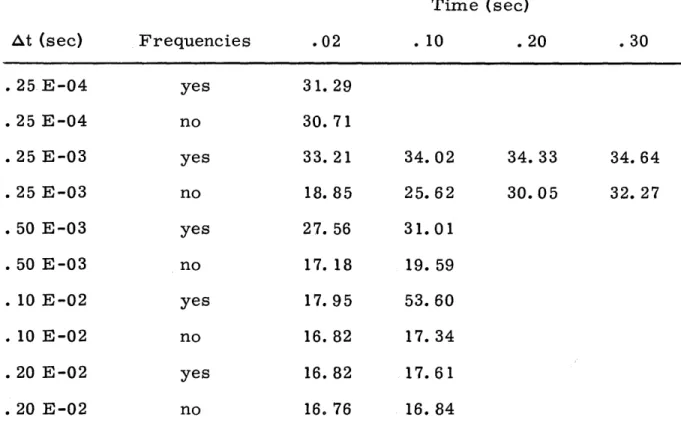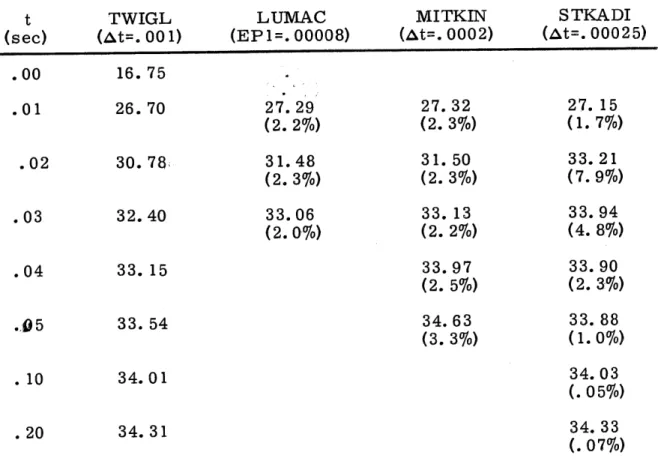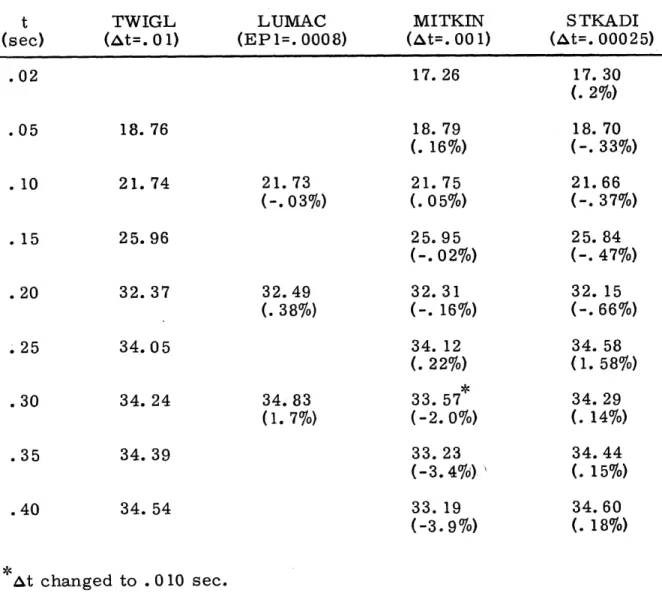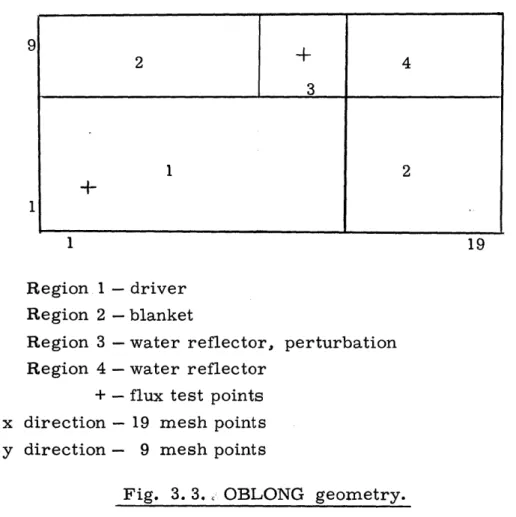-r . , -S , A -A . i-F F -|-- I .I.| - Il - II4 - L5- --- - ~il -1W I - -I l - I - - " I eL -I ' I
$
---I | o , -- -Ap A C - lF F - - - r - .F " T lo w I1
-. . -| - . - 0-| .. | I i -- I- - - J . .I -- I I1 - - I -I~~ - ~ ~~~~~ I ~ - I ~~~~~ - -3
- -e A--
_ - - " M MMTMX ." .|| -%-- - .THE APPLICATION OF ALTERNATING -DIRECTION IMPLICIT METHODS TO THE SPACE-DEPENDENT KINETICS EQUATIONS
by
ALAN LEONARD WIGHT
B. E. , University of Saskatchewan, Saskatoon Campus (1965)
B.A., University of Saskatchewan, Regina Campus (1966)
S. M. , Massachusetts Institute of Technology (1967)
SUBMITTED IN PARTIAL FULFILLMENT OF THE REQUIREMENTS FOR THE DEGREE OF
DOC TOR OF PHILOSOPHY
at the
MASSACHUSETTS INSTITUTE OF TECHNOLOGY August, 1969
Signature of Autho
Department of Nuclear Engineering, August 18, 1969 Certified by
Accepted by
Thesis Supervisor
Chairman, Departmental Committee on Graduate Students
NUCLEAR ENGiNEERING
2
THE APPLICATION OF ALTERNATING--DIRECTION IMPLICIT METHODS TO THE SPACE-DEPENDENT KINETICS EQUATIONS
by
Alan Leonard Wight
Submitted to the Department of Nuclear Engineering of the Massachusetts Institute of Technology on August 18, 1969 in partial fulfillment of the requirements for the degree of Doctor of Philosophy.
ABSTRACT
An approximate solution of the multigroup neutron diffusion kinetics equations with delayed neutrons in two-dimensional geometry can be ob-tained by matrix splitting methods based on an Alternating-Direction Implicit (ADI) scheme. The method is shown to be consistent and numer-ically stable. An exponential transformation of the semi-discrete equa-tions reduces the truncation error so that the method becomes useable for practical computations. The results of numerical experiments are presented to illustrate the accuracy and stability of the method. These results indicate that another splitting method based on an Alternating-Direction Explicit scheme is slightly superior.
i
Thesis Supervisor: Kent F. Hansen Title: Professor of Nuclear Engineering
3 TABLE OF CONTENTS ABSTRACT 2 LIST OF FIGURES 5 LIST OF TABLES 6 ACKNOWLEDGMENTS 7 BIOGRAPHICAL NOTE 8 Chapter I. INTRODUCTION 9
Chapter II. THEORY 12
1. Properties of the 'A' Matrix 12
2. The Alternating-Direction Implicit Method 13
3. Properties of ADI 15
4. Stability 19
5. Fractional Step Method 23
6. Frequency Transformation 24
7. Iterative ADI Method 27
8. Comparison and Summary 30
Chapter III. RESULTS 33
1. Introduction 33
2. CASE 1 - Two Group Bare Homogeneous Reactor 35 3. FOURGP - Four Group Bare Homogeneous Fast
Reactor 38
4. TWIGL Problems - Two Group Non-Homogeneous
Reactor 39
4. 1 Positive Step Change in Reactivity 40 4. 2 Positive Ramp Change in Reactivity 44 4. 3 Negative Ramp Change in Reactivity 44 5. OBLONG - Non-Homogeneous, Non-Symmetric
Reactor 45
6. Other Methods Tested 51
4
Chapter IV. CONCLUSIONS 53
1. Conclusion 53
2. Recommendations for Further Work 53
REFERENCES 54
Appendix A. THE NEUTRON DIFFUSION KINETICS EQUATIONS 56
Appendix B. THEOREMS 63
Appendix C. DATA FOR TEST PROBLEMS 76
C. 1 CASE 1 - Two Group Bare Homogeneous Reactor 76
C. 2 FOURGP - Four Group Bare Homogeneous Reactor 77 C. 3 TWIGL Reactor - Two Group Non-Homogeneous
System 78
C. 4 OBLONG Reactor - Four Group Non-Homogeneous,
Non-Symmetric System 80
Appendix D. COMPUTER PROGRAM (only in first 5 copies) 83
D. 1 Description 84
D. 2 Main Program - STKADI 87
D. 2. 1 Listing of STKADI 94
D. 2. 2 Listing of ASSIGN 102
D. 2. 3 Listing of CNTROL 104
D. 3 The STEP Package 105
D. 3. 1 Listing of STEP 107
D. 4 The DATIN Package 129
D. 4. 1 Listing of DA TIN 132
D. 5 The FDBACK Package 141
D. 5. 1 Listing of FDBACK 143
D. 6 The CALC Package 149
D. 6. 1 Listing of CALC 151
D. 7 Program - DIGEST 163
D. 7. 1 Listing of DIGEST 164
D. 7. 2 Listing of DIGEST ASSIGN 167
D. 8 Other Routines 171
D. 8. 1 Listing of Other Routines 172
l-pl-INI-i-, p l Into
5
LIST OF FIGURES
No. Page
2. 1 System to be solved on first half-step. 16
3.1 Error for CASE1. 37
3. 2 "TWIGL geometry. 40
3.3 OBLONG geometry. 46
A.I Two-dimensional mesh. 60
A.2 Central differencing matrix, W g. 60
A.3 Differencing matrix, Y , for the 'y' direction. 61
A.4 Differencing matrix, X g for the 'x' direction. 61
A.5 The 'A' matrix. 62
6 LIST OF TABLES
No. Page
2
2. 1 Comparison of 0(At ) and O(At) approximation. 28
2. 2 Comparison of various methods. 31
3.1 Storage requirements. 34
3. 2 Computing times. 34
3.3 Results for CASE1 at .4 seconds. 36 3. 4 FOURGP results - comparison with MITKIN. 39 3. 5 Results of TWIGL case, positive step change. 41 3. 6 TWIGL results - comparison with other methods. 42 3. 7 TWIGL positive ramp - comparison of results. 43 3. 8 TWIGL negative ramp - comparison of results. 44
3. 9 OBLONG results, fast group, region 1. 47
3. 10 OBLONG results, fast group, region 3. 48
3. 11 OBLONG results, thermal group, region 1. 49 3. 12 OBLONG results, thermal group, region 3. 50
3. 13 Unuseable methods. 52
A. 1 Definition of symbols - scalars. 58
A. 2 Definition of symbols - matrices. 59
D. 1 Storage for the 'A' matrix. 86
D. 2 Control parameters in common block /CNTROL/. 88
D. 3 Variables in STKADI. 91
D. 4 The STEP package. 106
D. 5 The DATIN package. 130
D. 6 The FDBACK package. 142
D. 7 The CALC package. 150
7
ACKNOWLEDGMENTS
The author would like to thank Prof. K. F. Hansen for his support and guidance throughout the course of this work.
The author would also like to thank William T. McCormick, Jr., and William H. Reed for their many ideas and numerical results, and Dr. John
Yasinsky for the results of the TWIGL code.
The author would also like to thank the National Research Council of Canada for their Scholarship support.
The work was performed under USAEC Contract AT(30-1)-3903. Computation was performed on the IBM 360/65 computer at the MIT Information Processing Center.
The author would like to thank his wife, Gerry, for her support, encouragement, and patience during the course of this work.
The author would also like to thank the typist, Mrs. Esther Grande, for her skill and effort in the preparation of this manuscript.
8
BIOGRAPHICAL NOTE
Alan Leonard Wight was born on October 11, 1943 in Regina, Saskat-chewan, Canada. He received his elementary and secondary education in various communities in the Province, and graduated from Martin Col-legiate Institute, Regina, on June 30, 1961.
Mr. Wight attended the College of Engineering, University of Saskat-chewan, Saskatoon, Sask. , with a Union Carbide Undergraduate Scholar-ship. He graduated in May 1965 with the degree of Bachelor of Science in Engineering Science (Physics) with Great Distinction. He subsequently enrolled in the College of Arts and Sciences at the University of Saskat-chewan, Regina Campus, and received the degree of Bachelor of Arts in May 1966 with Great Distinction as the College's "Most Distinguished Graduate" of that year. He enrolled in the Massachusetts Institute of Technology in Sept. 1966, and was granted the degree of Master of Science in Sept. 1967.
Mr. Wight was married to the former Geraldine Genieve Weidman of Groton, Mass. in Sept. 1968.
-9
Chapter I INTRODUCTION
The current trend toward very large power reactors, in which the space-time effects can become limiting design considerations (Refs. 1, 2), requires the development of methods of predicting the transient behavior of the neutron flux as a function of position as well as time. An enormous amount of effort has been directed toward this problem.
In the following dissertation ws shall be concerned with methods of calculating the flux in two-dimensional geometry for reactor transients sufficiently rapid that time derivatives of the flux are not negligible. This eliminates xenon oscillation problems, burnup calculations, and other long period reactor changes.
The methods to be presented are intended to be applicable to a very general class of problems. However, it is intended that they should be useful as "numerical standards" against which other faster, but more approximate, methods can be tested, and in the analysis of reactor accidents.
To obtain the flux, we use the multigroup neutron diffusion kinetics equations with delayed neutrons. The problem can be written in the semi-discrete form (see Appendix A):
A
T (1. 1)dt =A aIt
where I'is a vector of group fluxes and delayed neutron densities at
10
every mesh point in the reactor and A is the 'A' matrix which describes the kinetic properties of the reactor. The multigroup equations and the
'A' matrix are discussed in detail in Appendix A.
Formally, the solution of the initial value problem (1. 1) can be writ-ten (for
A
constant):q(t) = exp(t
A)
1(0), (1. 2)where T(0) are the initial conditions. The purpose of this thesis is to in-vestigate methods of computing an approximate numerical solution of Eq. (1. 1) which are based on an Alternating-Direction Implicit (ADI) type of approximation (Ref. 3). These are part of a general class of
"Matrix Splitting" methods (Refs. 4, 5).
The problem (1. 1) is difficult to solve because the characteristic times of the system vary from the asymptotic period (order of seconds) to the prompt neutron life time (fractions of microseconds for some sys-tems). Stated another way, the eigenvalues of A vary from order +1 in-verse second to order -10 inverse second. Also, the methods are diffi-cult to analyze mathematically because A is not Hermitian, and because the spacial dependence of the problem prevents its being Fourier trans-formed.
In Chapter II the basic method will be presented and analyzed from a mathematical point of view, then several modifications of the basic method will be presented and discussed. Numerical solutions for several
sample problems have been obtained using these methods, as well as using other methods currently under development (Refs. 6, 7) or in use (Ref. 8). In Chapter III these methods will be compared with respect to accuracy
11
and computing time.
The computer code, STKADI, written in FORTRAN IV for the MIT System/360/65 computer to test the methods is described and listed in Appendix D.
12
Chapter II THEORY
1. Properties of the 'A' Matrix
Before discussing methods of obtaining an approximate solution of Eq. (1. 1) we shall first review some of the properties of the matrix A.
A is a real, square, irreducible matrix with non-negative off-diagonal elements. This is an "essentially positive" matrix by Def. 8. 1, page 257 of Varga (Ref. 9). Thus by Varga's Theorem 8. 1, exp (tA-K) is positive for all t > 0, and by Theorem 8. 2, A has a real, simple eigenvalue, w , such that
i) to 0 there corresponds a positive eigenvector e ,
ii) if w. is any other eigenvector of A, then Real (w.) is less than
o , and
iii) o is increased if any element of A increases.
In addition, we know from Theorem 8. 3 that exp (tA) exhibits asymp-totic behavior given by
.flexp(tA) ~ K exp( 0t), (2.1)
as t -- co, K some constant independent of t.
This leads us to the following observations about the solution, T, of Eq. (1. 1) for non-negative initial conditions:
i) $'(t) > 0 all t > 0 since exp(t-A) > 0, and '(0) > 0, 1(0) * 0, ii) as t becomes large,
||Z(t)
11 is bounded by K exp(o0t), andiii) we can subtract a constant diagonal matrix from A to make an
13
Furthermore, by Theorem 1 in Appendix B, the solution behaves asymptotically like:
$(t) a exp( 0t) e0 as t - oo, (2. 2)
where a =
(e9,
(0)) -0.2. The Alternating-Direction Implicit Method
The solution (1. 2) of Eq. (1. 1) can be obtained in principle from the convergent series:
exp(tA) V(O) = (I+ tA +(tA) 2/21 +... (tE)n/! +...) T(0). (2.3)
This is generally not feasible in practice for two reasons:
i) the number of terms required, and the number of computations needed for each additional term make the computing time prohibitive, and
ii) round-off error will swamp the solution long before the series
converges.
To obtain an approximate solution of Eq. (1. 1), we replace the time derivative by a forward difference over a time interval, At, and calcu-late a series of approximate solutions XF at discrete times, t., assuming A constant over At. The algorithm for computing qj+1 from Tj is ob-tained as follows:
A is split into the sum of two parts:
A
=A
+A2
(2.4)where
A1 X + 2 =+ L
-.& -. & -.b A 2 = Y + L.
14
X is a symmetric matrix of one half of the diagonal terms of A and the off-diagonal stripes associated with diffusion in one direction. Y con-tains one half of the diagonal and off-diagonal stripes associated with diffusion in the perpendicular direction. (See Appendix A.) U contains
the remaining elements of A which appear above the diagonal, and L those which appear below. Then with h = At/2, we write
j + 1 / 2 - j + 1 / 2 + A 2 (2. 5) j+1 _hj+ 1/2 - j+ 1/2 + j+ 1 h A1 TA2T 1 or equivalently, f+/hA 2=
(hiA+/
j,
(2. 6 a) (TI-hA;) Uj+1 2 j+1/2, (2. 6b)where Tj+1/2 is an intermediate vector which is actually computed. The name Alternating-Direction Implicit derives from the diffusion term in one direction being handled implicitly in one half step, and ex-plicitly in the next, according to the scheme of Peaceman and Rachford (Ref. 3). The L and U matrices are treated as in the Gauss-Seidel method, with the L and U alternately implicit.
The linear systems implied by Eqs. (2. 6) can be easily solved by taking advantage of the block structure of the matrices. After the matrix multiply (I - hA ) is performed, we are left with a system that looks
15
like Fig. 2. 1 if we divide out h and incorporate I/h into the diagonal blocks. The system Y1 u = can be solved quickly by elimination since
Y
is tridiagonal. Starting in group 1, we solve for all U1, which is then available for back substitution when solving for u2. The process is repeated until all the energy group fluxes are obtained. The delayed groups then require solution of systems. A nG+i G+i which is trivial since 'A. is diagonal. For the next half-step the procedure is the same,1
except the solution proceeds from bottom to top. No iterations are re-quired at any stage of the computation.
By substituting (2. 6a) into (2. 6b) we obtain a formal expression for the advancement matrix
E
j
_ 1 (h) ir = (If- h 2) (I+ h (+hA ) . (2.7)3. Properties of ADI
The advancement matrix B(h) can be rewritten in a form more con-venient for analysis:
E(h)
= I + 2h(I- hA2 1)~ F . (2.8)This gives immediately:
Property 1 - For the exactly critical, *steady-state reactor, T =
A
i = 0, - 1 -& _ .T = B' (h) I = TI, which is the exact solution, independent of h.
For the general problem we are more concerned with:
Property 2 - The advancement matrix B(h) is a consistent approximation to the solution of (1. 1).
T
21
Y
2
31 32 3 0 0 0 TG,G-1 YG P 11 P212P
21P
22 P Il P2I2Fig. 2.1 - System to be Solved on First Half-Step
H 0l'
A
1
ui
U
2U
3 UGU
G+1UG+
2UG+I
V
1 . VG+l VG+1A
2
AI
*17
"Consistency" assures us that the method does in fact approximate the solution N(t) for "sufficiently small" time steps. The consistency prop-erty is proven in Theorem 5, Appendix B.
If we assume h sufficiently small that we can expand B(h) in a power series, we get
.h) = + 2hA + 2h 2 A 2 + . ... (2.9)
Comparing this to the expansion:
exp(AtA) = exp(2hA) = I + 2hA + (2hA) 2/21 + ... , (2. 10)
we arrive at
Property 3 - B(h) agrees with the expansion of exp(AtA) to terms in
and hence is said to be "accurate to order (h "
This property is verified experimentally in Chapter III, Section 2. Theorem 2, Appendix B, shows that the inverses, (
-hA
) and-11
(-hA 2) , are non-negative. Since the fundamental eigenvector, e , is positive, we can establish:
Property 4 - If o >-- 0, the component of the solution vector P in the direction of e is nondecreasing.
This assures us that the fundamental component will grow when it should, although it does not guarantee that it will grow faster than all other com-ponents, nor that it will grow with the correct period.
18
-j - -)-1 (
B (h) = (I/h-A 2 ) (I/h+A 1)(I/h*A )~ /h+A 2). (2. 11)
In the limit as h becomes very large, I/h becomes negligibly small, and
B(h) - (-A 2) (A 1 )(-A )~ (A2 I.
Thus:
Property 5 -As the time step becomes very large, the advancement ma-trix, BJ(h), approaches the identity operator, I.
This property helps explain the observed tendency for the ADI to under-predict the growth (or decay) of the solution as the time step is increased. More precisely, the growth (or decay) of each eigenvector in the solution is underpredicted, depending on the product h I. Thus, if the initial con-dition contains a large amount of a component with a large negative eigen-value, that component will die away very slowly, resulting in considerable error in the computed solution vector, even though the fundamental is well approximated.
The eigenvalues of BJ(h) are the solutions of
tJ(h) V. = v (2. 12) 1 1 1 or if we let 1 + hv. .= 1- hv(2. 13) 1i 1 - hv. we can write (2. 12) as (1+hv )(f-hA 1 f-h M2) i~ = (1 hv)(+hA (I hA This reduces to ... .. ... ...
19
-- - 2- -
-hA v =hv v. + (hv ) h A 1A2 i. (2. 14)
Thus the eigenvalues v and eigenvectors vi are solutions of the charac-teristic equation:
(I+h2A A 1 2 A v. = v.v.. (2. 15)
i i
Comparing (2. 15) to the characteristic equation for A,
A 1 = 1I1. e (2. 16)
we see that vi and v. are approximations to o and ei accurate to order (h2). Furthermore, the eigenvalues of Bj(h) are approximately
1 + hv. 1 + hw. i = 1 - hv 1- hw. + O(h) 1 1 2ho. 2 = e 1 + 0(h2). (2. 17) 4. Stability
To be useable a numerical method cannot allow some error in the solution vector to grow faster than the correct solution; that is, the method must be stable. To insure stability, \we require that the solu-tion should remain bounded for finite time and finite time step. More precisely, we use the definition of stability of Richtmyer and Morton (Ref. 10):
Definition: The advancement matrix, B(At), is stable if there exists a constant, b, such that
20
for
0 < NAt = T, O < At 4 -T.
This condition can be satisfied if the solution grows by no more than a factor (1 +KAt), K some constant, with each time step.
We must impose an additional requirement on the definition above.
bj 2
B (h) contains quantities of the form h v D fAx arising from the approx-imation to the diffusion operator which become very large as A x2 be-comes very small. The upper bound in (2. 18) must be either independent
2
of Ax , or, if this is too strict a requirement, then an upper bound must exist with the ratio r = h v D /Ax 2 held fixed.
We first consider the stability of the problem obtained by setting the intragroup transfer terms (including delay-group transfers) to zero to obtain the symmetric matrix, a = X + Y. Thus:
S(h) = (I- hY (I+hR)(I-h) (I+hY). (2. 19)
Theorem 3 shows that ej(h) is unconditionally stable if and only if all the eigenvalues of X and Y are non-positive. Using Gerschgorin's Theorem, we can show that this is true if the net group production term on the diag-onal,
g =Xg( 1-p)(v f) g - ,ag (2.20)
is, negative.
The matrix Bj(h) can be written as a sum of (2. 19) and a bounded perturbation of order (h). Thus:
21
where
IIQ(h)
11 < q, all h. Bj(h) certainly cannot be stable if (h) is not, and conversely if 23(h) is stable andQ(h)
bounded, Ed(h) must be stable. (See Ref. 10.)(h) can be shown to be stable as follows:
Ej(h)N
- 2 2) (I+ hA(I- -1CIA1)C hA- 1) hA 2) .~ ~ (Ih C . .' ~A6$h
,- hX 2) 1
(I- hA2) (hI - i) . ..
(I - h-A2) B'(h)N h 2* Now B'(h) = 6 1(h) B2(h), with B 1(h) = (I+ hA 1) - hA' )~ and
E
2 (h) = (I+A
2 2Now we can manipulate B 1(h) to obtain
B 1 (h) =
I-hi)~
(I + hX) + 2h(I - hA 1)- U(I -h)-(2. 22)
22
Now if Condition (2. 20) is satisfied, Theorem 4 establishes that Q 1(h) is
bounded:
Q 1(h)fj q (2.23)
Furthermore, all the eigenvalues of X are negative, and
p(n1(h)') = 1 1(h)J1 < 1. Thus jJBl(h) 11 < 1 + 2hq1 < eatq (2.24) Similarly, 2(h)
j
1 + 2hq2 e Consequently,II'B(h)N
1. 11 (1 - hA2) ' (h)NShA
SC e qT = b IlaI-h 2(q
+q2)t N 11 - 11 (1 - hA.2 (2. 26)since the condition number
-.
(Ih|
-
h
I(I
hA)
is bounded by a constant for 0 < h < T < o.
If t he time step varies over the computation, or the elements of A are functions of time, then we select the maximum J|I
|
11 andlI
2|
1, and23
perform the same analysis.
The above analysis has not assumed that the reactor is homogeneous, has placed no restriction on the number of neutron or delayed groups, and has placed no restriction on h or T other than that they be real, posi-tive and finite. The only restriction is that the diagonal production term, T ,g be negative, a condition which is almost always satisfied in prac-tice. Thus the basic method is unconditionally stable.
5. Fractional Step Method
Physically meaningful problems have flux distributions which are everywhere positive. Consequently any negative elements which would appear in the approximate solution T would render the solution unuse-able in practice. Unfortunately, since the matrices (I+hA2) and1+ hA1)
are non-negative only for very small h, the ADI does not necessarily produce a positive solution even when the initial vector is positive. Since we know that the exact solution with positive initial conditions is positive, we seek a method which shares this property.
The advancement matrix
B (At) =
(I-
AtA2)~
( (I AtA )1 (2. 27) is a consistent approximation, and is non-negative. It is accurate to O(At) and stable for all At. Unlike the basic ADI method, it is not ex-act for the exex-actly critical problem, nor can the solution be guaranteed to grow when it should. In fact, for very large At,24
lim -B(At) =lim 2 (I/At-A2)- (I/At-A 1) At-oo At-oo At
1 2 1 1
S (-A 2) (-A1)A At
Thus for large At, the solution decreases as At increases.
6. Frequency Transformation
Numerical experiments have shown that the basic ADI method of Section 2 is not sufficiently accurate. A large improvement in the
accu-racy of the method results from a simple change of variable. We define a transformation from the relation
- Ot
-I'=e ' (2.28)
with Q a diagonal matrix. The equation for i' then becomes
=T e -0t(A - E-) e t'
A'
I T (2. 29)If T(t) has a basically exponential behavior, then ''(t) should be a smooth modulation, and hence well approximated by a simple difference.
Now (2. 29) is identical in form to (1. 1). We thus attempt a solution as before. We first integrate over h to obtain
y h
T'(h) - '(0) = A'(t) -'(t) dt 0
=hA'(h/2)
1'(h) + hA'2(h/2) '(0), (2. 30)evaluating
A'(t)
half way between the end points. ...25
By reversing the roles of A' and A'2(t) on the next half step, and using12 some algebra, we obtain
T = exp Q2 h n) (I-h(A 2
+ h
A1
-$ - hAA
- h(A21exp(1 h
)
, (2.31)after using (2. 28) to transform back to '.
tQ..
The matrix exp(t 0) is a diagonal matrix of elements (e 11) and con-sequently is simple to evaluate. The remaining terms of (2. 31) are the basic ADI method applied to the matirix (A-Q). We shall call this the
"Transformed ADI" -method,
and
the matrix,B(h,)= exp( h) I-h( A2 ~ 2
-(I+h(A, -I) (I-h(Al - 1 I+h A2
exp (h ), (2.32)
the "Transformed Advancement Matrix." Since 0 has units of sec~, we shall call it the "Frequency Matrix," and its elements "frequencies."
i is to be chosen in such a way as to minimize the error in the solu-tion. It is not obvious a priori how to do this, but a method which has proven extremely successful in practice is to take advantage of informa-tion available from the previous step, and compute
26
log
i = 2h .(2. 33)
Thus the solution growth over the previous step is used to estimate 0 to be used in the present step.
This requires storing ' as well as , so that the transformed
ADI requires three times as much storage as the basic ADI method. For the first step S = 0 is used.
If Q were held constant throughout the calculation, and the condition
(a- 9 - S.i) < 0 (2. 34)
gg i
were always satisfied, then the transformed ADI would have the same stability properties as ADI. However,
O
is changed at each step, allow-ing feedback effects to cause instabilities.If the solution has become asymptotic, i. e. ,
-j = j-1 (2.35)
and
then
j+ 3/2wh I2h~-hA2-I-(A-o
A-)e1/2wh
-j= ~~ e~ j2h I - h(A -I - h -(A A l4 o (A.
Hence (A-w) '4 = 0 since the inverse matrices are non-negative. Thus
27
and the solution is proportional to the fundamental eigenvector of the sys-tem. Thus we say the solution is "asymptotically exact."
7. Iterative ADI Method
It is not always true that an Order (At 2) method is superior to an 0(At) method. To illustrate, consider the following rather simple example:
-49.5 50.5 50.5 -49.5 for which e1 ~ 1 e 1 and
[1
=2 100, e =-'J
Note that the eigenvalues are greatly different in order of magnitude. Let us consider two approximations to exp(AtA):
B 1(At) = (+ hA)(I- hA), (2.36)
B2(At) = (I - At A), (2.37)
and an initial vector,
2
x = e 1+ e = (2. 38)
12 2
28
If we take time step At = . 1, and operate with B 1, B2 and exp(AtA)
sepa-rately on each eigenvector, we get the results shown in Table 2. 1. Thus,
Table 2. 1. Comparison of 0(At 2) and 0(At) approximation.
Coefficient of Each Component in Solution Component
Ei
(0(At2)) B2 (0(At)) exp(AtA)e 1.106 1. 111 1.105
e2 -. 667 .0909 .000042
Ilx(At)
11 1. 292 1. 113 1. 105error .187 .008 .0
although B 1 better approximates the growth of e1, B2 better
approxi-mates the decay of e2, and, in the final result, B2 gives the better
ap-proximation.
Although the above example is contrived, it is not a completely un-realistic example. For real reactor problems, the eigenvalues are separated by many orders of magnitude, such that hu
f
> 1 for the larg-est (in magnitude) eigenvalues. Since one picks time steps such that the fundamental and perhaps a few of the smaller (in magnitude) eigenvalue components of the solution are well approximated, most of the error in the solution by the ADI method comes from the larger eigenvalue compo-nents. If these are present in a large amount in the initial vector, which they may well be in a problem with much spacial dependence, the error will be quite large. Thus for some problems an approximation like B229
To use the advancement matrix
-. A-tf (2. 39)
B(At) = (I - At
A-)~
2 9we must solve a system of equations:
(Y - At
A)
9j+1 _ (2.40)at each step. This is simply the linear system
U
X =Y,
U
= ~I - AtA (2.41)which can be solved by an ADI iterative method as follows: Assuming a starting value of X obtained by some method (ADI for example), define a splitting of G analogously to the ADI method
G =G 1 + G 2 (2.42)
G = At(f/2AtA 1) (2.43)
U2
= At(I/2AtA
2). (2.44)The iteration scheme then becomes
(Rk+G1) -k+1/2 _ k 2 'k +
(2.45) ( k+1 2 k 1 k+1/2 +
(R k G2) Xk+ (Rk= G1 + Y
where Rk is some positive diagonal acceleration (or optimization) matrix. If this method is to be used in practice, some scheme for determining
op-timal Rk to speed convergence would have to be invented. However, to test the method the selection
30
was made because it was particularly easy to code with the subroutines already available.
An alternative strategy for treating large eigenvalue components is to reduce the time step of the ADI method. In order to be competitive, the Iterative ADI method must employ fewer iterations to achieve the same
error reduction than the alternative requires additional steps. In a rather artificial test problem to which the method was applied, it did as well as the ADI, but for the one "practical" problem to which the method was applied, it was very little improvement over the basic method with the same time step, and required four times as much computing. (See Chapter III, Section 5.)
Another iterative method, TWIGL (Ref. 8), uses a much faster iter-ation scheme, but still appears to require more iteriter-ations than other, non-iterative methods require steps, although comparisons are difficult since these problems were not run on the same machine. The TWIGL method is compared with other methods in Chapter III, Section 4. In general, it appears that the longer time step that iterative methods allow costs more in terms of computing time than non-iterative methods.
8. Comparison and Summary
The various ADI methods discussed in this chapter are summarized in Table 2. 2. The requirement that o be negative is not considered as a practical restriction, and is assumed to hold for all methods.
Of the four methods, only the Frequency Transformation can be un-stable for some problems. However, the results in Chapter III demon-strate conclusively the great superiority of this method over the others
Table 2. 2. Comparison of various methods. Truncation
Error Eigenvalue Eigenvector Advantages Comments
0(At2) ADI Fractional Step Iterative ADI Frequency-Transformed ADI O(At) O(At) better than O(At2 1+h + ( 2 1 - hw. 1 1-tc, + O(At) 1 1 - Atw. I &
2
e+o(h
e + O(At) e. 1 w At e 0 e (asymptotically) Uncondition-ally stable Advancement matrix is non-negative Improved ap-proximation for compo-nents having large negative eigenvalues Asymptotically exact, trunca-tion error much better than basic ADITruncation error too high
in practice
At's small
enough to make
this method ac-curate are also small enough to make ADI non-negative
Requires itera-tion at each step
Unstable for some problems
W..
I I11,1 I11 10 1 11a _ I - _ _
_ -. _-_II__ ,
32
for a broad class of problems. The other three methods may have some limited application to problems where the Frequency Transformation is
unstable, but otherwise it is the method of choice.
33
Chapter III RESULTS
1. Introduction
The ADI method and variations described in Chapter II have been coded in FORTRAN IV for the IBM 360/6 5 computer. The listing and program description of STKADI are in Appendix D. Several trial problems have been run to test the method. The results of these numerical experiments will be discussed in the following sections.
The same problems have also been run on the computer codes LU-MAC (Ref. 6) and MITKIN (Ref. 7). LUMAC is a two-dimensional ver-sion of GAKIN (Ref. 22) which uses a buckling approximation for the sec-ond dimension. MITKIN uses a splitting method very similar to STKADI,
except that it is based on an "Alternating-Direction Explicit" approach. The solutions from these two codes will be compared with those from STKADI.
The storage requirements of STKADI are summarized in Table 3. 1. In addition, the program itself requires 11, 500 eight byte words of core
storage. Thus a problem of 1000 mesh points, 10 groups, 6 delayed groups and 20 regions requires 120,000 words.
The observed computing times per step on the 360/65 are listed in Table 3. 2 for various trial problems with and without the frequency trans-formation, and compared to the reported computing times for the MITKIN
and LUMAC codes.
The number of floating-point multiplications (and divisions) in one step of STKADI is given by
34
Table 3. 1. Storage requirements.
Data Stored
Number of Words of Storage Required Diffusion Coefficients
Intragroup Transfer Terms
Delayed Neutron Production Terms Delayed to Neutron Group Transfer
Terms
Delayed Group Decay Constants Flux Vector
Frequency Vector
Flux Vector for Previous Step Total N G I R 4 X G X R G2 XR G X I X R I X G XR I N X (G+I) N X (G+I) N X (G+I) 3N(G+I) + RG(G+ 21+4) + I
number of mesh points number of energy groups number of delayed groups
number of regions
Table 3. 2. Computing times.
I STKADI 1 1 1 1 6 .21 .45 .89 .94 .23
Computing time in seconds/step
STKADI MITKIN (frequencies) .36 .71 1.51 1.49 .41 .33 . 56 1.34 1.20 N G 81 81 361 171 38 2 4 2 4 2 LUMAC .46 .90 1.75 1.75
35
Nf(G, I) = N(186 + 81 + 561 + 2G2), (3. 1)
where terms small compared to N are neglected. In addition, the fre-quency transformation requires two exponential and one logarithm evalu-ation for each unknown.
Assuming that the total computing time per step is proportional to the number of floating point multiplications, and the additional computing time required by the frequency transformation is proportional to the number of unknowns, the total computing time can be written
T = aN(f(G, I) + y (I+ G)). (3.2)
We obtain the constants using the data in Table 3. 2. They are
a = . 41 X 10 sec/step/mesh point
15.2 with frequencies 0. without frequencies.
Thus the 1000 mesh point, 10 group, 6 delayed group problem requires 40 seconds per step or about 70 minutes to do a 100-step problem.
2. CASE 1 - Two Group Bare Homogeneous Reactor
CASE 1 is a two energy group, one delayed group thermal system. The reactor is a homogeneous square, 200 cm on a side with nine mesh points (ten intervals) in each direction. A positive step change in reac-tivity of about forty cents is inserted at time zero by a decrease of .0000369 cm~ in the thermal capture cross section. The initial condi-tions correspond to the steady state. Data are given in Appendix C.
36
The solution was calculated using various time steps with and without the frequency transformation. The results at t = .4 second are shown in Table 3. 3. The percentage error is plotted in Fig. 3. 1.
From Table 3. 3 and Fig. 3. 1 it is clear that the frequency transfor-mation is far superior to the basic method. The former achieves less than 1% error with time steps of about . 00 1 second, the latter requires time steps of one-tenth this or smaller to achieve the same error. How-ever, the transformation increases the computing time by about 70% so that the over-all improvement is about a factor of six.
Table 3. 3. Results for CASE 1 at .4 second.
Without Frequencies With Frequencies
At (sec) Group 1 Group 2 Group 1 Group 2
Exact 1. 566 .600 1. 566 .600 .0080 1.002 .384 1.061 .407 (36. %) (36. To) (32.%) (32.%) .0040 1.010 .387 1.389 .532 (35.%) (35. %) (11. %) (11. %) .0020 1.037 .398 1.647 .631 (34.%) (34.%) (-5.2%) (-5.2%) .0010 1.127 .432 1.572 .603 (28.%) (28.%) (-.4%) (-.4%) .0005 1.315 .504 1.566 .601 (16.%) (16.%) (-.06%) (-.06%) .00025 1.482 .568 (5.3%) (5. 3%) .000125 1.544 .592 (1.3%) (1. 3%)
37 10% --...
x
without frequencies -with frequencies .1% ---.0001 .001 .01time step in seconds Fig. 3. 1. Error for CASE 1.
38
Note that the thermal flux (without frequencies) for At = .008 and
At = . 004 differs by only . 8%, which in the absence of other information
might lead one to conclude that the solution had converged and was accu-rate to within 1%. Obviously this conclusion would be incorrect. This points out the danger of using the agreement of the solution at two dif-ferent time steps to establish convergence. However, looking at the
differences between the solution at the three largest time steps reveals that the percentage difference actually increases with decreasing time
step, revealing that the solution is not converged. This can be used as a quick check on convergence of any method which has a characteristic error curve like Fig. 3. 1.
2 The asymptotic convergence rate of the basic method is 0(At2) as expected, while the convergence rate for the transformed method is slightly faster.
3. FOURGP - Four Group Bare Homogeneous Fast Reactor
FOURGP is a four energy group, one delayed group fast system. The reactor is a homogeneous square, 150 cm on a side with nine mesh points (ten intervals) in each coordinate direction. A positive step change in reactivity of about 60 cents is inserted by changing the critical value of v by +. 00172. Initial conditions correspond to the steady state of the system. Data are given in Appendix C.
Solutions were obtained with STKADI using the frequency transfor-mation at time steps of .2 X 10-5 and . 4 X 10-5 seconds. These are
compared with the solution obtained from MITKIN in Table 3. 4.
39
Table 3. 4. FOURGP results - comparison with MITKIN.
Thermal flux, with frequencies.
MITKIN (At=. 4E -5) 005473 (-. 15%) 006378 (-. 0 5%) .007148 (-. 0 1%) .007805 (.01%) 008364 (. 02%) STKADI (At=. 4E-5) .004949 (-9. 7%) .005927 (-7. 1%) .006931 (-3.0%) .007793 (-. 14%) .008489 (1. 5%) STKADI (At=. 2E-5) .005419 (-1. 1%) .006352 (-. 5%) .007139 (-. 13%) .007804 (.01%) .008366 (.06%)
Note: Numbers in parentheses ( ) are percentage errors.
to the STKADI results at one-half this time step. Recalling that MITKIN takes less execution time than STKADI, it is apparent that MITKIN is better than STKADI for this problem by a factor of at least two.
4. TWIGL Problems - Two Group Non-Homogeneous Reactor
This series of problems was prepared at Bettis Atomic Power Labo-ratory (Ref. 11) to test the TWIGL (Ref. 8) Code. The reactor consists of a square core surrounded by a blanket with blanket in the interior as well. It is completely symmetric. The geometry is shown in Fig. 3,.2.
The transient is induced by changing the thermal cross section in region 1. Three different transients were studied: a positive step change in reactivity, a positive ramp change in reactivity, and a negative ramp
Time (sec) .00000 .00016 .00032 .00048 .00064 .00080 Exact .004475 .005481 .006381 .007149 .007804 .008362
40 21 3 18 1 2 1 414 0 Ax=8.0 cm e 2 3 2 Ay=8.0 cm 8 1 -Driver Region 1 2 1 2 -Core Region 4 3 -Blanket Region 1 1 4 8 14 18 21 x mesh points
Fig. 3. 2. TWIGL. geometry.
change. Solutions were obtained from the TWIGL, LUMAC, MITKIN and STKADI codes.
Data are given in Appendix C.
4. 1 Positive Step Change
A positive step change in reactivity of about 50 cents is introduced at time zero by reducing the thermal capture cross section in region 1 by .0035 cm~ .
Although the problem is space-dependent, the change in flux shape is quite small. The thermal flux at the mesh point at the exact center of the reactor is used as a basis of comparison. All other points behave similarly.
41
STKADI solutions were calculated with and without frequency trans-formation using several different time steps. Results are summarized in Table 3. 5.
Table 3. 5. Results of TWIGL case, positive step change.
Thermal Flux at Center of Core
Frequencies yes no yes no yes no yes no yes no .02 31. 30. 33. 18. 27. 17. 17. 16. 16. 16. 29 71 21 85 56 18 95 82 82 76 Time (sec) .10 .20 34. 25. 31. 19. 53. 17. 17. 16. 02 62 01 59 60 34 61 84 34. 33 30. 05 Initial flux is 16. 75
The great superiority of the transformed method over the untrans-formed is again evident. The latter is converged at 25 microsecond time steps, while the former is acceptably accurate at a time step ten times as large.
Table 3. 5 shows the tendency of the ADI to approach the identity oper-ator as the time step becomes large. Both methods exhibit this, although
At (sec) . 25 . 25 . 25 .25 . 50 .50 .10 .10 .20 .20 E-04 E-04 E-03 E-03 E-03 E-03 E-02 E-02 E-02 E-02 .30 34. 64 32. 27 wl..W_. -- Adwxd"Ltw - , , , , , ., ,
42
the transformed method approaches unity much more slowly. The result at t = . 1 sec, At = . 0010 seems anomalous. Apparently the frequencies at the beginning of the transient were quite large, and became "locked in" on subsequent steps because the ADI was so close to the identity that the frequencies could not decrease.
The transformed ADI method is compared with the other methods in Table 3. 6. The computing times required by STKADI and MITKIN were
Table 3. 6. TWIGL results - comparison with other methods. Thermal Flux at Center of Core
TWIGL (at=. 001) 16. 75 26. 70 30. 78 32.40 LUMAC (EP1=. 00008) 27. 29 (2.2%) 31.48 (2.3%) 33.06 (2.0%) 33. 15 33. 54 34.01 34.31 MITKIN (At=. 0002) 27. 32 (2. 3%) 31. 50 (2. 3%) 33. 13 (2. 2%) 33.97 (2. 5%) 34. 63 (3. 3%) STKADI (at=. 00025) 27. 15 (1. 7%) 33.21 (7.9%) 33.94 (4.8%) 33.90 (2. 3%) 33. 88 (1.0%) 34. 03 (.05%) 34.33 (.07%)
Note: Numbers in parentheses
( )
are the percentage deviation from the TWIGL results.t (sec) .00 .01 .02 .03 .04 .05 . 10 .20
43
very similar since a larger At compensates for STKADI's longer computing time per step. LUMAC takes three times as long for this problem. TWIGL
was run on another machine, so that computing times are not comparable. All the methods agree quite closely so that there appears to be little to choose among the four methods on the basis of accuracy. Hence MIT-KIN and STKADI are superior to LUMAC because of their shorter running times.
Table 3. 7. TWIGL positive ramp - comparison of results.
Flux in Center TWIGL (At=. 0 1) 18. 76 21.74 25. 96 32.37 34. 05 34. 24 34.39 34.54 of Core LUMAC (EP 1=. 0008) 21.73 (-. 03%) 32.49 (.38%) 34. 83 (1. 7%) MITKIN (At=. 00 1) 17.26 18. 79 (. 16%) 21. 75 (.05%) 25. 95 (-. 02%) 32.31 (-. 16%) 34. 12 (. 22%) 33. 57* (-2. 0%) 33. 23 (-3. 4%), 33. 19 (-3.9%) STKADI (At=. 00025) 17.30 (. 2%) 18. 70 (-. 33%) 21.66 (-. 37%) 25. 84 (-. 47%) 32. 15 (-. 66%) 34. 58 (1. 58%) 34. 29 (. 14%) 34.44 (. 15%) 34.60 (. 18%) At changed to .0 10 sec.
Note: Numbers in parentheses ( ) are percentage deviations from TWIGL results. Thermal t (sec) .02 .05 .10 .15 .20 25 30 .35 .40 ....
44
4. 2 Positive Ramp Change
A positive ramp change in reactivity of about 2. 5 dollars per second
is introduced over the time interval . 0 < t <. 2 seconds by reducing the
-1
thermal capture cross section in region 1 by (.0035)(t/.2) cm~
The results'are compared in Table 3. 7 with TWIGL, LUMAC and MITKIN. Agreement is excellent.
4. 3 Negative Ramp Change
A negative ramp change in reactivity of about 80 dollars per second
is introduced in the interval .0 < t < .02 seconds by increasing the ther-mal capture cross section in region 1 by .03 (t/.02) cm~
The results are compared in Table 3. 8 with TWIGL and MITKIN.
Table 3. 8. TWIGL negative ramp - comparison of results.
Thermal Flux at Center of Core
t TWIGL (sec) (At=. 00 1) .000 .010 .020 .030 .040 16.750 8.154 4.594 4.442 4. 385 MITKIN (At=. 0002) 16. 750 7.445 (-8. 7%) 4. 573 (-. 5%) 4.388 (-1. 2%a) 4. 385 (. 0%) S TKADI (at=. 00025) 16.750 8.178 (. 3%) 4.605 (. 2%) 4.141 (-. 6%) 4. 377 (-. 2%)
Note: Numbers in parentheses ( ) are percentage deviations from TWIGL results.
45
As with the positive ramp, the agreement is excellent.
5. OBLONG - Non-Homogeneous, Non-Symmetric Reactor
The TWIGL problem is completely symmetric and shows very little change in flux shape over the transient (<5%). A severe test of a space-time method requires a sample problem with no symmetries whatsoever, and a significant change in flux shape. The OBLONG problem was de-signed for that purpose (Ref. 12).
The reactor is a four energy group, one delayed group system. It is a rectangle, 160 by 80 cm divided into four regions as shown in Fig. 3. 3. Region 1 is a driver region, region 2 is a blanket region, and regions 3 and 4 are a water reflector.
The transient is induced by a ramp change in the thermal cross
sec-tion in region 3 over the time interval . 0 < t 4. 2 seconds. Data are
given in detail in Appendix C.
Solutions were obtained from STKADI with the frequency transfor-mation, using various time steps. The results are presented in Tables 3.9 through 3. 12 for the fast and thermal fluxes at the points in regions 1 and
3 shown by crosses in Fig. 3. 3.
The MITKIN results quoted are the most accurate available (Ref. 13). They differ from the MITKIN results at twice and four times the time step by only a few parts in 1000. Also, the good agreement with the LUMAC results, which are converged to within one per cent (Ref. 6), indicates that the MITKIN solution is accurate to better than a fraction of one per cent.
46
1 19
Region 1 - driver Region 2 - blanket
Region 3 - water reflector, perturbation
Region 4 - water reflector + - flux test points
x direction - 19 mesh points
y direction - 9 mesh points
Fig. 3. 3., OBLONG geometry.
excess of 5% persist even at a time step of one quarter that used by MIT-KIN. The results are not even self-consistent - differences between
suc-cessive STKADI runs are as large as the discrepancy with MITKIN. After the end of the ramp, the solution exhibits a large but damped oscillation. MITKIN also shows this behavior, but to a much lesser extent (Ref. 13).
The failure to converge for reasonable time steps and the excessive oscillations in the solution indicate that the ADI is not a satisfactory method for this problem.
The iterative ADI method (ITRADI) is about 25% efficient for this problem, taking 4 iterations per step to converge. The solution obtained is almost -exactly the same as the STKADI solution at the same time step,
OBLONG results, fast group, region 1.
Group 1 flux at point (2, 8)
t MITKIN (sec) (4t=. 0005) . 000 .025 .050 .075 .100 . 150 .200 .250 .300 .4463 .4515 . 4566 .4620 .4677 .4804 .4954 .4961 .4965 LUMAC (EP1=. 8E-4) .4569 (. 06%) STKADI (At=. 000125) STKADI (At=. 00025) .4468 (-1. 0%) .4525 (-. 910) STKADI (IAt=. 0005) 4463 (-1. 2%) .4463 (-2. 3%) .4640 (.4%) .4730 (1. 1%) .4830 (.5%) .4930 (-. 5%) .5123 (3. 2%) .4781 (2. 2%) .4985 (3.8%) .5064 (2. 2%) .5225 (5. 3%) .5194 (4. 6%) .4508 (-3. 6%) .4918 (-. 7%) .5609 (13. %) .4464 (-4. 5%) .4486 (-9. 5%) .4624 (-6. 9%) STKADI (At=. 0010) .4462 (-1. 2%) . 4463 (-2. 3%) .4463 (-3. 4%) .4463 (-4. 6%) .4463 (-7. 1%) .4463 (-9. 9%) .4464 (-10.
%)
.4465 (-10. %) ITRADI (&t=. 0010) .4463 (-4. 6%) .4465 (-9. 9%) I~I HUll Table 3. 9.OBLONG results, fast group, region 3.
Group 1 flux at point (11, 2)
t MITKIN (s ec) (At=. 000 5) . 000 .025 .050 . 075 .100 .150 . 200 .250 . 300 . 1341 . 1363 .1385 . 1408 .1432 .1488 . 1552 .1555 o 1556 LUMAC (EP1=. 00008) .1385 (.0%) STKADI (A~t=. 000 125) . 1350 (-1. 0%) .1375 (-. 7%) STKADI (at=. 00025) STKADI (At=. 0005) . 1342 (-1. 6%) . 1346 (-2. 8%) . 1419 (. 8%) 1453 (1. 4%) 1499 (. 8%) .1551 (-. 07%) . 1605 (3. 2%) .1473 (2.8%) .1554 (4. 5%) -. 1604 (3.3%) . 1653 (6.4%) . 1640 (5. 4%) .1394 (-2.7%) . 1558 (.4%) .1768. (13.%) .1371 (-4. 3%) . 1413 (-8. 9%) .1489 (-4. 3%) STKADI (At=. 00 10) 1341 (-1. 6%) .1342 (-3. 1%) - 1343 (-4. 6%) . 1346 (-6.0%) . 1359 (-8.6%) . 1382 (-11. %) .1411 (-9. 2%) . 1438 (-7. 6%) ITRADI (,&t=. 00 10) .1352 (-5. 6%) . 1403 (-9. 6%) co 'I-r (sec) (At=. 0005) Table 3. 10.
OBLONG results, thermal group, region 1.
Group 4 flux at point (2, 8)
t MITKIN (sec) (At=. 0005) .000 .025 .050 .075 . 100 .150 .200 .250 .300 .0359 .0364 . 0368 .0372 . 0376 .0387 .0399 .0399 .0400 LUMAC (EP1=. 8E-4) .0368 (.07%) .0381 (1.2%) .0389 (.6%) .0398 (-.2%) .0412 (3. 1%) STKADI (At=. 000125) .0360 (-1.0%) .0364 (-. 9%) .0374 (.4%) .0385 (2. 2%) .0401 (3. 7%) .0408 (2.2%) .0420 (5. 3%) .0418 (4. 6%) STKADI (At=. 00025) STKADI (At=. 0005) .0359 (-1.2%) .0359 (-2. 2%) .0363 (-3. 5%) .0396 (-. 7%) .0451 (13%) . 0360 (-4. 5%) .0361 (-9. 3%) .0373 (-6. 7%) STKADI (At=. 0010) .0359 (-1. 2%) . 0359 (-2. 3%) .0359 (-3. 4%) . 0359 (-4. 5%) .0359 (-7. 1%) .0359 (-9. 8%) .0359 (-10. %) .0360 (-10. %) co PIIN l ITRADI (at=. 00 10) .0359 (-4. 5%) .0360 (-9. 8%) Table 3. 11.
OBLONG results, thermal group, region 3.
Group 4 flux at point (11, 2)
t -M4TKIN (sec) (At=. 000t) . 000 .025 .050 .075 * 100 * 150 .200 .250 .300 . 9684 1.0101 1.0540 1.1013 1.1525 1.2686 1.4075 1.4105 1.4116 LUMAC (EP1=. 00008) 1.056 (. 2%) 1.166 (1.2%) 1.278 (.7%) 1.410 (.2%) 1.451 (2. 8%) STKADI (At=. 000125) 1.0010 (-. 9%) 1.0474 (-. 6%) 1.1105 (.8%) 1.1855 (2. 9%) 1.3278 (4. 7%) 1.4565 (3. 5%) 1.5023 (6. 5%) 1.4920 (5. 7%) STKADI (At=. 00025) STKADI (At=. 0005) .9950 (-1. 5%) 1.0255 (-2. 7%) 1.1204 (-2. 8%) 1.4133 (.4%) 1.6094 (14. %) 1.1006 (-4. 5%) 1.2914 (-8. 2%) 1.3498 (-4. 4%) STKADI (At=. 0010) .9939 (-1. 6%) 1.0223 (-3. 0%) 1.0535 (-4. 3%) 1.0873 (-5. 6%) 1.1614 (-8. 4%) 1.2498 (-11.%) 1. 2726 (-9. 8%) 1.2889 (-8. 7%) ITRADI (At=. 0010) 1.0879 (-5. 6%) 1.2652 (-10. %) eji 0 "IEEE Table 3. 12.
51
and is certainly no more accurate. Several other modifications of the basic ADI method were also tried on this problem. They were unstable.
Thus it appears that methods based on the splitting (2. 4) are inappropriate for this problem.
6. Other Methods
Several variations of the basic method were considered, and rejected. Table 3. 13 outlines these variations and the reason for rejection.
Table 3. 13. Unusable methods.
Reason for Rejection 1. Iterating~on the frequency
matrix, S2, to obtain an
improved approximation 2. Selecting 5% at step
j
from:3. Leaving group transfer terms entirely explicit 4. Using a weighting scheme
for the o terms on the diagonal of A; that is, 9E was left on the RHS and (1-9)o was taken to the LHS
5. Leaving U matrix implicit on both half steps
6. Weighting schemes for other elements of A matrix
7. Recalculating 0 every half step
8. Rearranging order of com-putation to:
(I+hA (I - hA 1)
(I+hA2)(1 - hA2) 9. Using two or three
pre-ceding time steps to cal-culate the frequency
10. "Smoothing" the frequency matrix by averaging at
each mesh point over four nearest neighbors
Iteration did not converge for model problem
A simple trial problem showed that it was unstable
Accurate to only 0(At), requires storing both old and new flux
For the OBLONG problem the follow-ing results were obtained (with fre-queneles):
9 =. 0 - unstable
9 = . 5 - exactly the same as
STKADI
9 = 1. 0 - unstable
Unstable for OBLONG problem using frequencies
A wide variety of ADI schemes were tested at Bettis and found to be- unsat-isfactory because of high truncation error and instability (Ref. 14)
Unstable for OBLONG problem
Unstable for OBLONG problem
Either unstable or less accurate than standard method for OBLONG prob-lem, depending on weighting factors used
Unstable for OBLONG problem Method
53
Chapter IV CONCLUSION
1. Conclusion
The ADI method with the frequency transformation is superior to all other ADI methods considered for the general kinetics problem. How-ever, the Alternating Direction Explicit (ADE) method (Ref. 7) with fre-quency transformation is comparably accurate in some cases, and far
superior in others, to the ADI. Since the ADE is also a faster method, the ADI method is inferior to it for the solution of the general kinetics problem.
The failure to STKADI to treat the OBLONG problem adequately is the decisive factor in this conclusion. To be generally applicable, a
space-time method must be able to handle problems with a great deal of spacial dependence. STKADI was not able to do this, and consequently cannot be regarded as a promising method.
2. Recommendations for Further Work
The ADI method handles the spacial differencing by splitting the hor-izontal and vertical differencing matrices; the ADE by splitting into a lower and an upper triangular matrix. Other differencing schemes (nine point, triangular, etc.) are possible which suggest different splittings, which may lead to even lower truncation error. Work should be continued to find even better splitting methods for the problem (1. 1).
